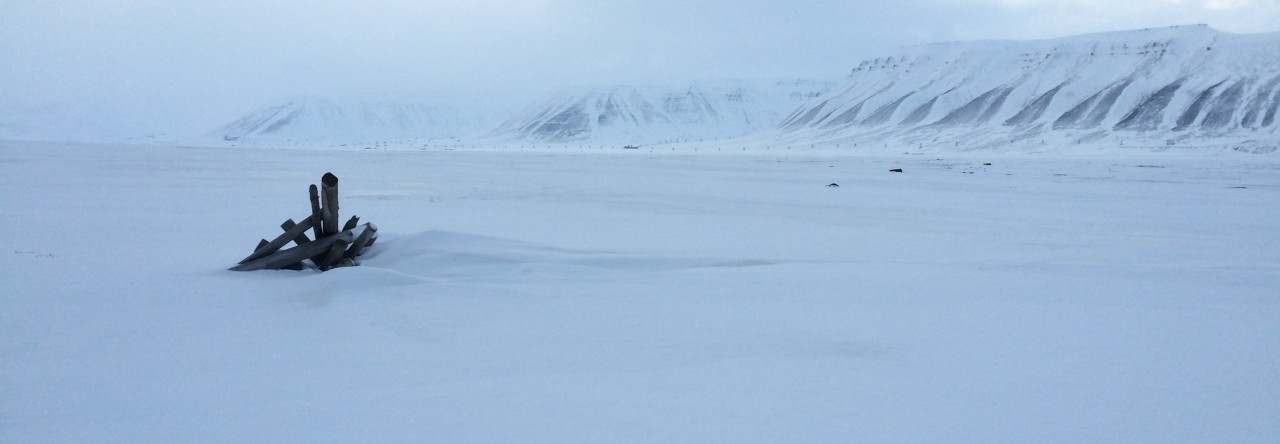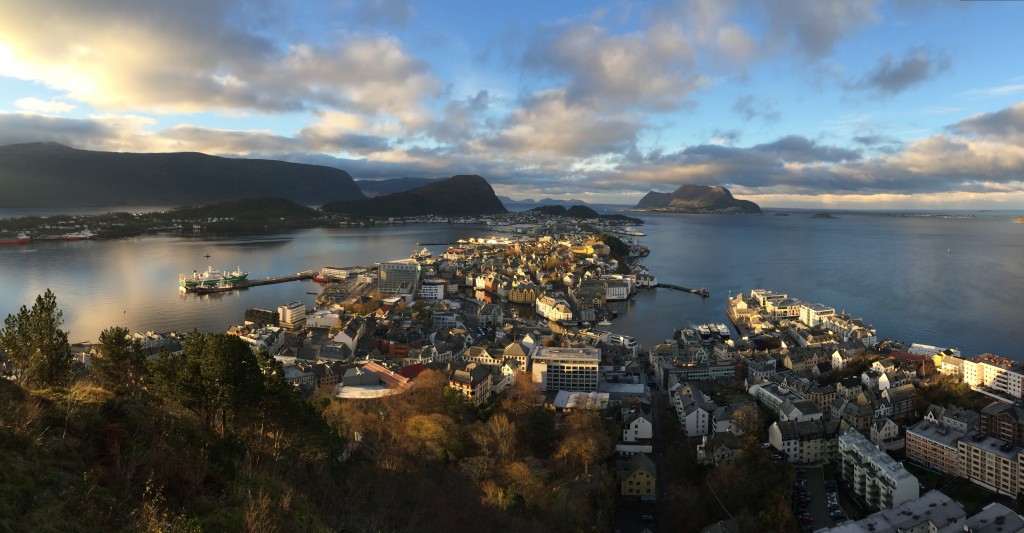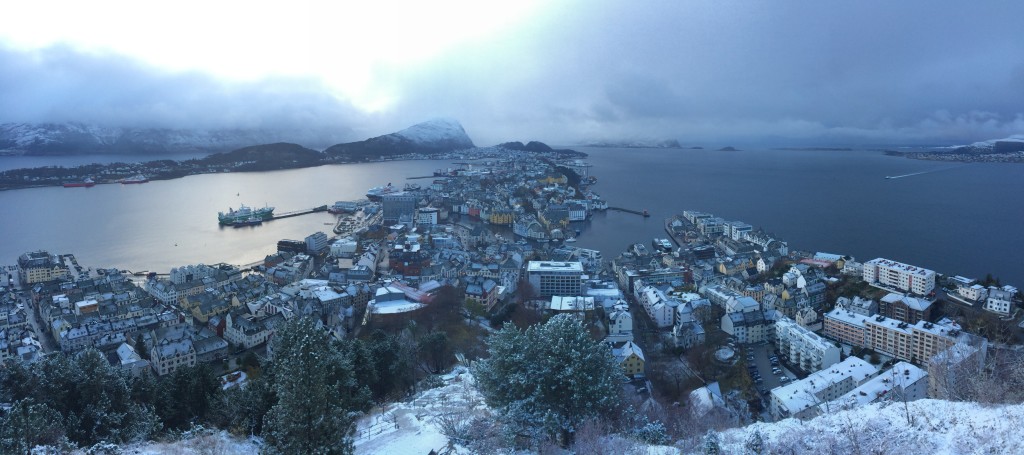The past couple weeks have been memorable—and travelt, the Norwegian word for “busy,” which is especially appropriate for this job, what with all the travel-ing! Planes, trains, and automobiles this week, plus busses, and all along the west coast. Early last week I visited Åsane videregående skole in Åsane, a sort of suburb just north of Bergen (Åsane means “the hills,” which I think is appropriate, given Bergen’s landscape). The school building is, the teachers told me, a former umbrella factory (which is also appropriate, given Bergen’s climate). Then to Ålesund, self-proclaimed prettiest city in Norway (I’m not going to argue [see below]). Then a stint in the quaint town of Gran, snug in the historical district of Hadeland (winter did a little work in the valley while I was there, though it’s since taken a pause). Lastly, I paid a visit to a few rain-beaten islands off the west coast near Haugesund: Stord, Bømlo, and Karmøy.
Åsane sticks out in this visit, for a special reason: I went to prison. Along with their usual curriculum, Åsane VGS has the responsibility for the education program in Hordaland’s prisons. I’ve been lately thinking about prisons a lot, what with the sort of renewed focus on our American “criminal justice” system effected by the racial violence and all of the forces that have given rise to Black Lives Matter. In fact, my Civil Rights presentation is called #BlackLivesMatter and in it, I pay some attention to the deeply troubling statistics of the American prison system. So it was a timely and rewarding opportunity to visit two Norwegian prisons—especially in this context, as a teacher. I visited both Bjørgvin Fengsel, a low-security prison, and the high-security Bergen Fengsel.
My experience was inspiring. For the sake of privacy, I won’t, in fact, say much about the specifics of my visit, but the teachers I worked with were wonderful and the inmates I encountered seemed genuinely interested in the topics I presented. Talk about rewarding.
Americans, in the main, find Norwegian prisons shocking in their humanity, it seems. Yet, Norwegian prisons are often lifted up as an example of “how to do prison right.” (I just googled “global prison recidivism rates” and the first page of results contained numerous articles about the comparative success of Norway’s criminal justice system.) Norway has a reputation of treating its inmates humanely, as members of communities (and, notably, as tax payers) whose have suspended their right to participate fully and freely in open society because of their decisions, or, of course, actions. Thus, the motive that determines the operations of Norwegian prisons rehabilitation, as much as it is to punish. In the US, our system is primarily a punitive system. You do a bad deed, you go to prison, you feel bad, you maybe get to breathe fresh air sometimes, lift some weights, say, etc. You “do your time”—sometimes a lot of it—and then, if you “behave,” you come out into the world again. And if film and TV have anything to say, you also get threatened or abused by other inmates while you’re there, especially in higher security prisons. I had some really great conversations with teachers, on the other hand, about the motivations that govern Norway’s “correctional” system. First and foremost—først og fremst—as a collectivist (as opposed to an individualistic) society, Norway’s concern (I feel like I’m a character in Hamlet, talking about “Old Norway”) is that members of the folk, or folket (our “We the people”), are full participants in Norwegian society. There is a national interest, for example, in populating the whole country, even the distant north. Compare northern Sweden, for example, to northern Norway just across the border, and you’ll find quite a difference in population density. This extends to prison: if you’ve done something that warrants suspension of your full participation, i.e., if you’ve broken the social contract, the goal is to help you repair it. And if you provide something that resembles (even while it is, by definition, an exception) civic life, with work to do, intellectual questions to explore, vocational skills to practice, social changes to learn about, inmates, especially if they’ve served longer sentences, will be less likely to find the “outside world” an alien, unwelcoming place, with an inhumane learning curve. I don’t have to describe all of this, to be sure; there are plenty of articles and resources that take on these issues. And I want to be clear: prison in Norway is still prison. You don’t want to go there; it’s not a cake-walk or a mere slap on the wrist or thoughtless tsk-tsk. It is a prison. It’s just that it’s less demeaning and dehumanizing than what we’re wont to imagine in the US.
But it’s worth adding that, as it turns out, the reparation of the social contract also means you contribute economically to the nation. That may smack of opportunism, but when full participation also means paying taxes again, and when those taxes are used to provide a real, humane social safety net for those in serious need, well, that’s a pretty good thing. Moreover, it is, both here in Norway and in the US, wildly expensive to keep an inmate in prison. So getting people out of prison is wise by several measures, whether you’re a humanist, a capitalist, or a socialist. That’s something to think about. To be even a tiny, tiny part of that process of rehabilitation (and, to be honest, rehabilitation aside, to have great conversations with interested people in a particularly complex situation) was, for me, an honor. I will value those moments long and long.
There’s certainly a lot more to say about prisons, and about my (brief) experience there (I didn’t even talk about the fantastic bike maintenance program a teacher at Bjørgvin fengsel is running!), but I’ll save those deeper reflections for in-person conversations. As for the rest, I’ll leave it to a couple of images that capture my lucky pair of days in Ålesund. The first was a pitch-perfect morning, and I had just enough time before heading to school to clamber up (ok, it was a very sleek staircase) to the fjellstue on Aksla, a hill overlooking the town from which many of the famous images of Ålesund are made (a sort of Ålesund-ian version of Seattle’s Kerry Park). The late-morning sunlight rendered the city in stunning detail, with that half-golden hue only angular northern light imparts. The next day shocked the scene into snow, and hung that unmatchable blue over all things. I suppose it’s normal for these parts. But then, each place has its normal, and for we, the visitors, a glimpse of that normal startles the sensibility.
But then, I hope the initiated never lose that startle, either.



john
twin pics of Ålesund r very clever, well done
Adina
I want to go there. I hope my parents will come see you. I got to drive their Volvo for a few days and it was awesome. The CRV has died now and Jack is taking the Cadillac to PDX in January, so what is left for me? I enjoyed your cryptic article about prisons there. I will be taking over your Romantic literature lecture next week, despite the fact that I was lambasted by my colleagues for telling the students that Beyonce singing “America the Beautiful” was “moving.”